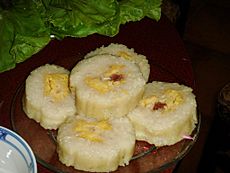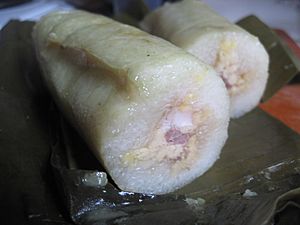Bánh tét facts for kids

A plate of bánh tét, with mung bean paste filling; with banana leaf removed and sliced into thick wheel-shaped slices just prior to serving
|
|
| Course | Snack |
|---|---|
| Place of origin | Vietnam |
| Region or state | Southern Vietnam |
| Main ingredients | Glutinous rice, banana leaf, meat or vegetarian filling (such as mung beans) |
| Other information | Traditionally consumed during Tết |
Bánh tét is a special Vietnamese cake. It is usually savoury, but can sometimes be sweet. It is made mostly from glutinous rice.
The rice is rolled inside a banana leaf. This creates a thick, log-like shape. Inside, there is a filling, often with mung beans or a mix of mung bean and pork. After wrapping, the cake is boiled. When it's ready, the banana leaf is taken off. The cake is then cut into round slices for serving.
Contents
What Does Bánh Tét Mean?
The word bánh tét is used for this cake. It is eaten during Tết, which is the Vietnamese New Year. However, "tét" in the name actually means "sliced" or "split." This probably refers to how the cake is served in slices.
The word "Bánh" is used for many different baked and grilled foods in Vietnam. It can mean small cakes, sandwiches, crepes, or spring rolls.
How Is Bánh Tét Made?
Making bánh tét is a long process. It usually starts when families get ready for Tết. First, all the ingredients are gathered. These include glutinous rice, mung bean paste, or soaked mung beans and pork belly.
Next, these ingredients are carefully placed in layers on banana leaves. Then, the leaves are wrapped tightly around the ingredients. Strings are used to hold everything together. To make sure the banana leaf stays wrapped during cooking, bánh tét is often wrapped again. This is done several times with plastic ribbon or rope. Finally, the wrapped cakes are boiled in a large pot of water for at least six hours.
Bánh Tét and Vietnamese New Year
Bánh tét is a very important traditional food for the Vietnamese Lunar New Year. This holiday is also called Tết. It shows how important rice is in Vietnamese culture. It also has a lot of history.
During Tết, families often gather together. They enjoy eating bánh tét as a main part of their festive meal. This celebrates the coming of spring. Making bánh tét takes a lot of time. But it is a tradition that many families still follow today. Even though pre-made bánh tét can be bought, many choose to make it themselves. This effort is important. It gives family members a chance to spend time together. They bond and celebrate the holiday spirit while making this special treat.
The cake is eaten during the Vietnamese Lunar New Year holiday. People often dip it in fish sauce, sometimes with chili. It can also be eaten with pickled scallions. Another way to enjoy bánh tét is by frying it.
Bánh tét is most popular in central and southern Vietnam. There is a similar food in northern Vietnam called bánh chưng. Bánh chưng is rectangular, while bánh tét is cylindrical.
Historian Trần Quốc Vượng believes bánh tét is a version of bánh chưng. It developed when Vietnam expanded south in the 17th century. An old legend says that bánh chưng was first made 4,000 years ago. Prince Lang Lieu created it. The cakes were round and square. The round Day cake stood for the sky. The square Chung cake stood for the Earth.
- Bánh tét chuối is a sweet version of bánh tét. It has rice with banana and sweet red bean filling. This is steamed in banana leaves.
Bánh Tét in Cambodia
In Cambodia, bánh tét is known by a different name. It is called ansom or num ansom (Khmer: នំអន្សម, num ânsâm [nom ʔɑnsɑːm]).
See also
 In Spanish: Bánh tét para niños
In Spanish: Bánh tét para niños



